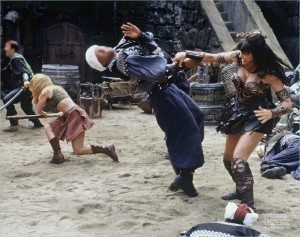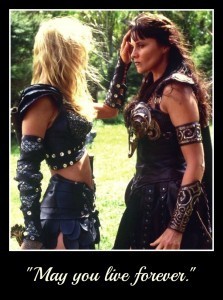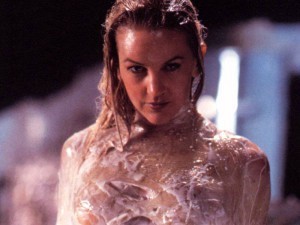Tansy Rayner Roberts's Blog, page 95
December 2, 2012
On Not Writing a Book – What Else is There?
 Sometimes blogging about not writing feels like the most subversive thing I can possibly do. I had my annual meltdown last week as I faced what I was and wasn’t going to be able to achieve this year, and my brain exploded messily all over the house. Only JUST metaphorically, I might add.
Sometimes blogging about not writing feels like the most subversive thing I can possibly do. I had my annual meltdown last week as I faced what I was and wasn’t going to be able to achieve this year, and my brain exploded messily all over the house. Only JUST metaphorically, I might add.
Now I am breathing calmly, having accepted that, you know, that novel I was working on is not going to be finished by the end of the school holidays, so I don’t have to kill myself in order to get it “done” before my next deadline window (for the second Livia Day novel) takes over.
Not when I have proofs to correct and much-closer-to-finished projects to edit, and submissions to make. And a house to clean up for Christmas and a tree to decorate and an insane number of end of year assemblies/concerts to attend.
Breathe, Tansy, breathe!
I haven’t finished anything substantial this year, nor have I made any substantial sales, but I have come to terms with that. It’s been a crazy year, and considering I wrote the Nancy novel straight after my mega trilogy (and have written two full length novels since my three-year-old was born, let’s put things in perspective here) I was due for a little taking-things-slower time.
Looking back on the year, while my mind and work have been scattered to the sixteen winds, I’ve managed to do a lot that I am proud of. I have been stretching myself as a writer, taking on challenges that I might not even have considered a few years ago. I’ve sold several non fiction pieces to paying markets, had my first reprint appear in a US book, and reached a personal milestone by being PAID for writing about Doctor Who. First Hugo nomination, plus the Peter Mac Convenor’s Award, thanks to Galactic Suburbia. (I only just realised that our title has the word ‘gal’ in it, who knew?)
Next year is Jem’s last full year before kindergarten starts (then one more year before she starts full time school) and I keep saying that I don’t want to wish that time away, though I do find myself thinking longingly about a future life where my days are almost entirely my own. Starting to think that those days are not going to be only for housework and writing fiction, though. I want to bring some regular money in for my family and writing sadly is not all that reliable an income. Yes, I am just accepting this now. Anyone would think I was a grown up!
Still, now is not the time for stress and worry. I made two big brave submissions this last week which I am very proud of. Next year sees the launch of Livia Day and the long-awaited (by me) release of A Trifle Dead. And I have plans, so many exciting plans and projects and new challenging things to throw at myself next year, culminating in our family trip to Brighton for World Fantasy Convention.
2013 is going to be awesome. See you all there!
November 30, 2012
You Killed Me? [Xena Rewatch Season 3 Overview]
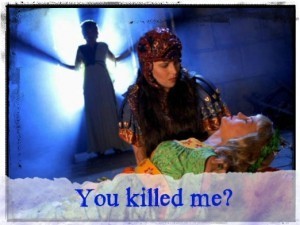 Let’s just say I meant to make this a separate post, and didn’t completely forget to add it to the end of Rolling Around Like Weasels.
Let’s just say I meant to make this a separate post, and didn’t completely forget to add it to the end of Rolling Around Like Weasels.
Season 3 was always my favourite season of Xena, the one where the concept for the show really came together with some brilliant, epic stories. It’s also the season where the production team seemed to relax into trusting just how good their main actors were at handling comedy, drama, fight scenes and sometimes all three at once.
Too many classic moments to count, from Xena’s manic obsession in Been There, Done That, to the martial arts (and other war movies) homages to Ancient China in The Debt. Not to mention the utter looniness of The Bitter Suite.
This is the season in which Gabrielle grew up, quite literally, to be more than Xena’s kid sidekick. We saw the two of them go through hell together and separately, saw them hate each other enough to kill, and love enough to forgive the past. All that by the time the season was half over!
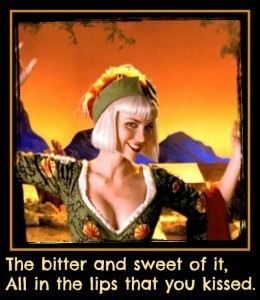 There are still the inevitable filler episodes, the by-the-numbers ones, and they feel more problematic in amongst the genuine angst and trauma of what I think of as the ‘real’ Xena stories. The balance was definitely off, particularly in the wake of the spectacular run of stories culminating in The Bitter Suite, when it felt at times like there was a reset button hovering in the wings (or, more likely, the scripts had been drafted in ignorance of the big emotional episodes, and had to have brief references tacked on to them but never quite resonated with the aftermath of those stories).
There are still the inevitable filler episodes, the by-the-numbers ones, and they feel more problematic in amongst the genuine angst and trauma of what I think of as the ‘real’ Xena stories. The balance was definitely off, particularly in the wake of the spectacular run of stories culminating in The Bitter Suite, when it felt at times like there was a reset button hovering in the wings (or, more likely, the scripts had been drafted in ignorance of the big emotional episodes, and had to have brief references tacked on to them but never quite resonated with the aftermath of those stories).
Season 3 brought development in several of the supporting characters. Kevin Smith’s Ares who had really started being interesting back in Season 2 was completely on fire by this point, and the chemistry he developed with Xena and separately with Gabrielle, Callisto and grown up Hope made all of his appearances deeply compelling – like Xena, his contribution to the comedy episodes works most effectively when he is the straight man, as in The Quill is Mightier, but he can turn on a dime to do the dark scary stuff too. Ted Raimi’s Joxer, who was on the verge of being one-note and over used in Season 2, was able to play beautifully on the melancholy (and occasionally creepy) aspect of his unrequited love for Gabrielle, and showed some real depth in episodes like Been There, Done That, King of Assassins and the first few scenes of The Bitter Suite. Both he and Autolycus got more of a dark and tragic backstory to round them out as characters.
 This season often looks more like an ensemble piece rather than a two hander show, with many repeat performances of characters, and new combinations. The Bitter Suite showed this quite literally, with many regular characters taking repertory roles in Xena and Gabrielle’s subconscious (representing of all things the characters of the traditional tarot deck), but it was evident throughout the run. If an episode doesn’t have Joxer, Ares, Autolycus, Aphrodite, Callisto, Caesar or Ephiny in it, it does feel a bit like a waste of time.
This season often looks more like an ensemble piece rather than a two hander show, with many repeat performances of characters, and new combinations. The Bitter Suite showed this quite literally, with many regular characters taking repertory roles in Xena and Gabrielle’s subconscious (representing of all things the characters of the traditional tarot deck), but it was evident throughout the run. If an episode doesn’t have Joxer, Ares, Autolycus, Aphrodite, Callisto, Caesar or Ephiny in it, it does feel a bit like a waste of time.
While I do enjoy some (not all) of the massive character development coming for the show, I will miss this era – which to me is most firmly represented by Gabrielle’s little green top, her adorable red boots, and her long fringed hair. Change is coming, and Xena: Warrior Princess will never be quite the same again…
Season Highlights:
The Furies
Been There, Done That
The Debt Parts 1 & 2
The Quill is Mightier
Maternal Instincts
The Bitter Suite
Sacrifice Parts 1 & 2
Season Lowlights:
Forgiven
King Con
Fins, Femmes and Gems
November 29, 2012
My Little Friday Links
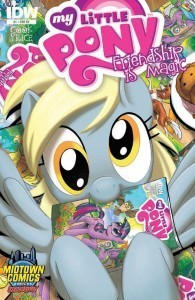 OK the news that really sparkled for me this week was the availability of the My Little Pony comics on ComiXology – which means I can actually access them! Oh, ComiXology, you are so convenient, if only your DRM-based platform wasn’t so inflexible and slightly evil. DID I MENTION PONIES?
OK the news that really sparkled for me this week was the availability of the My Little Pony comics on ComiXology – which means I can actually access them! Oh, ComiXology, you are so convenient, if only your DRM-based platform wasn’t so inflexible and slightly evil. DID I MENTION PONIES?
Alisa passed on a link to this inspiring article about Nicola Beauman and Persephone Books. There’s a lot to unpack in this one, particularly about the value of aesthetically pleasing books, but also the human side of “building a brand”. Warning: this article may make you buy books while reading it.
Mary Shelley blogs about the origins of her classic story Frankenstein. Yes, really. Well, a bit.
Jennifer Mills talks about reading Australian classics for the AWW challenge, and Elizabeth L Huede writes about the year’s challenge over at the Huffington Post.
Rebecca Fitzgibbon responds to the Hobart ABC closure, discussing some of the roll on cultural effects that come from not producing TV in Tasmania any longer. Sigh.
Alisa writes about her relationship with tea, which I found hilarious and very true to life – we all do that thing where we buy things for our imaginary self rather than the person we really are, right?
Rowena Cory Daniells is releasing an exclusively e-novella from the King Rolen’s Kin world, next week.
Slate looks at how to get more women in the writing room of TV comedy, and why gender balance makes for a better end product.
Jim C Hines posts a variety of links on issues to do with diversity and inclusiveness in SF fandom, including a shout out to Doctor Her!
Random Alex writes a heartfelt open letter to Nyx, the heroine and protagonist of Kameron Hurley’s intense and confronting bugpunk novels.
Sherwood Smith on the origins of flounces and fandom wank in the salons of old. Somehow a flamewar would feel so much more stylish if there were actual fans of the fluttering variety to smack each other with!
November 28, 2012
Missing: Presumed Trojan [WHO-50--1965]
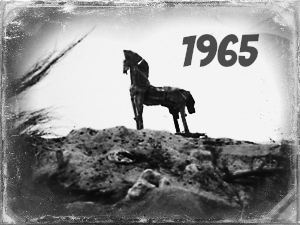 There comes a time in every young Doctor Who fan’s life when they discover that it is utterly impossible to complete their experience. Not because of the lack of home video in the old days, or because the show is so popular that it is going to be around beyond all possible human lifespans, but because some of the episodes are lost forever.
There comes a time in every young Doctor Who fan’s life when they discover that it is utterly impossible to complete their experience. Not because of the lack of home video in the old days, or because the show is so popular that it is going to be around beyond all possible human lifespans, but because some of the episodes are lost forever.
Quite a few of them, actually.
The hows and whys of that are all quite complicated – and I refer anyone who has a keen interest in the story to Richard Molesworth’s excellent book Missing: Presumed Wiped, but suffice to say, many of our favourite old Doctor Who stories from the 1960’s are inaccessible.
But we can still try to recapture what they were.
When I was little, at the very beginning of the VHS era, old Doctor Who stories could be shared (ahem) and exchanged between fans despite very few official BBC releases. This was to become less necessary over the 90’s as more and more stories were indeed released on VHS, and then gave way to the magnificent DVD range. Also from the 90’s onwards, audio versions of the missing stories (recaptured from fan tape recordings!) were released with narrated action, so you can hear if not see them. Many fans worked hard to create visuals for these in unofficial “recons.”
(Personally I’ve never seen a fan recon that was as easy to consume as the official audio releases with linked narration – the stills are good but the long silences are agony!)
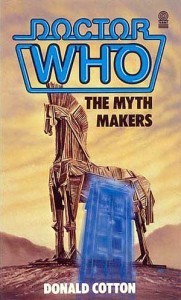 Before home video, there were the Target novelisations, and this epic series of short books was for a long time the only way that a completist fan could practically experience the older stories. While I saw quite a few scratchy black and white videos as a kid, and fell in love with stories like The Chase and The Mind Robber, many more were only available to me through the Target books. I read those things by the bucketload, even the ones for stories with the Fourth and Fifth Doctors, that were on high TV rotation and that we had recorded on a VHS.
Before home video, there were the Target novelisations, and this epic series of short books was for a long time the only way that a completist fan could practically experience the older stories. While I saw quite a few scratchy black and white videos as a kid, and fell in love with stories like The Chase and The Mind Robber, many more were only available to me through the Target books. I read those things by the bucketload, even the ones for stories with the Fourth and Fifth Doctors, that were on high TV rotation and that we had recorded on a VHS.
And so thanks to the power of books, The Myth Makers (written nearly 20 years after its original story screened in 1966) became my favourite First Doctor story as a kid, even as The Highlanders became my favourite Second Doctor one. Neither of them exist in the archives.
The Myth Makers is the Doctor Does Troy, and long before I heard the soundtrack version of the story, I read the slender paperback version over and over. I didn’t know much about the Trojan myths at the time, but enough to realise even as an eight-year-old that this was an audacious book.
The best and most fun of the Target novelisations were not necessarily the ones that actually captured what had happened on the screen of the TV show. Some got a bit experimental, and Doctor Who: The Myth Makers did exactly that. For a start, the story is narrated in second and first person, by Homer himself. Yes, the greatest and most iconic poet of human history didn’t start out writing epic heroic verse, he first honed his craft on a TV novelisation. As you do.
Donald Cotton wrote the screenplay as well as the novelisation, and was more aware than anyone that Homer does not in fact feature in the TV story, despite apparently witnessing it in its entirety in the book. The insertion of Homer as the “Cyclops” character, a one-eyed spy (who only appears briefly in the TV story & is ignominiously speared to death halfway through), adds a whole level to the book, showing that it had a secret history going on the whole time. But, hey. It’s this kind of glorious weirdness that I love most about Doctor Who.
 Once you get past the bizarre premise, it’s interesting now (with all my clever grown up book learning and such) to see how much about the Trojan cycle Cotton actually packed into this book. It’s a slightly old fashioned, fairly straight retelling of the myth, and doesn’t bat an eyelash talking about gory deaths and adultery, which explains a lot about why the Target series was so popular with kids.
Once you get past the bizarre premise, it’s interesting now (with all my clever grown up book learning and such) to see how much about the Trojan cycle Cotton actually packed into this book. It’s a slightly old fashioned, fairly straight retelling of the myth, and doesn’t bat an eyelash talking about gory deaths and adultery, which explains a lot about why the Target series was so popular with kids.
What surprised me most about The Myth Makers, though, when I listened to the soundtrack later and heard more analysis about the story, is most people think of it as a historical comedy romp along the lines of The Romans and The Gunfighters. This had never occurred to me, because I took the novel quite seriously and had no idea that Up Pompeii actor Max Adrian was, for instance, cast as Priam.
On rereading the book… well, yes. I get it now. The voice of “Homer” is quite sarcastic and amusing, undercutting the heroic story traditions at every turn resulting in a narrative that feels rather Douglas Adams.
Take this passage about the famous duel between Hector and Achilles, shortly before the TARDIS turns up:
Seams stretched and gussets gaped. On his head was a towering, beplumed horse’s head helmet, which he wore as casually as if it were a shepherd’s sheepskin cap: and this of course meant that he was a horse-worshipping Trojan, not a Greek. Furthermore, in view of everything else around him, he could only be the renowned Hector, King Priam’s oldest son and war-lord of Troy.
His opponent was a different matter; younger by some ten years, I would say, and with the grace of a dancer. Which he certainly needed, as he spun and pirouetted to avoid the great bronze, two-handed sword which Hector wielded – in one hand – as casually as though it were a carving knife in the hands of a demented chef.
On the other hand, the story is dark, too – it’s certainly not a fluffy farce in the same way that (my beloved) The Romans was. People are slaughtered left right and centre, and while many of the performances are amusing, some of the funniest characters such as Priam and Paris are lying dead by episode 4, which takes the gloss off the comedy. Plus, the ingenue lovers Vicki “Cressida” and Troilus are so very earnest… if this is a comedy, it’s more of an Ancient Greek take on that genre than a modern one.
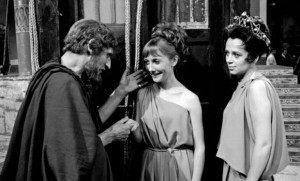 In 1965, the time travel aspect of Doctor Who was considered of equal important to the space adventures, with the characters often taking on the costumes and manners of the day to fit in. Where The Myth Makers is quite diabolical is that the TARDIS travellers get absorbed far too deeply in the story, each of them taking on or being given names that allow them walk-on roles in the war. Of course, for poor old Vicki, that meant a permanent change of address…
In 1965, the time travel aspect of Doctor Who was considered of equal important to the space adventures, with the characters often taking on the costumes and manners of the day to fit in. Where The Myth Makers is quite diabolical is that the TARDIS travellers get absorbed far too deeply in the story, each of them taking on or being given names that allow them walk-on roles in the war. Of course, for poor old Vicki, that meant a permanent change of address…
The Doctor, named Zeus after Achilles witnesses the arrival of the TARDIS and takes the opportunity to skewer Hector into the dust, has far too much fun in this story. Not content with being responsible for the death of one of Troy’s great heroes, he flits around in the Greek camp, hesitating to suggest the whole wooden horse concept to them (too obvious, & he’s convinced Homer made that bit up). Instead, he spends a couple of episodes happily playing with flying machines, and bantering with Odysseus.
Steven, meanwhile, is given the name of Diomedes, and disguises himself as a Greek warrior despite the extreme danger this puts him in as a futuristic astronaut with very few sword skills. Understandably, he spends most of his time in the Trojan cells, and ends up with a sword in his belly.
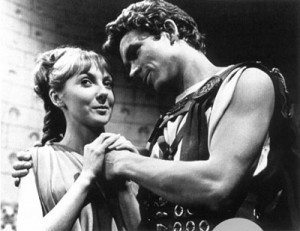 Vicki, also from the future, is made a pet of by Priam who names her Cressida, and despite the extreme lack of this character in the original myth cycle, the 1960’s interpretation of history involved a lot of Chaucer and Shakespeare (themselves great liberty takers) and that means Vicki’s future is set. She will marry Troilus. She and the lad therefore spend their whole time blushing and dancing around each other, and at one point poor old Steven has to sit in an adjoining cell while they flirt and make puppy eyes.
Vicki, also from the future, is made a pet of by Priam who names her Cressida, and despite the extreme lack of this character in the original myth cycle, the 1960’s interpretation of history involved a lot of Chaucer and Shakespeare (themselves great liberty takers) and that means Vicki’s future is set. She will marry Troilus. She and the lad therefore spend their whole time blushing and dancing around each other, and at one point poor old Steven has to sit in an adjoining cell while they flirt and make puppy eyes.
As a kid, without much historical context, I was a bit bewildered by this aspect, as surely that meant the Doctor was leaving her to die or be a prisoner of war in a burning, sacked city. Indeed, this is the one big failing of the novelisation, as being grounded in the point of view of a contemporary means that there is no sense of what happened next. Instead, we get the reunion scene of Troilus, grieving for his lost love, and Vicki, who has decided to stay with him, and no mention at all that they might have joined Aeneas, whose arrival in the final scene of the TV/audio version is fairly key to Vicki’s future.
Our girl is going to help found Rome.
There are so many clever bits in this story, in between the wacky character banter. The character of Paris is strangely likeable (I say this as a committed Paris-loather of long standing) mainly because he can do no right in the eyes of his family. The whole war is, after all, his fault. But the Doctor and crew insinuating themselves into the Greek-Trojan war, the TARDIS being taken into the city to foreshadow that business with the horse, the importance given to Cassandra as the voice of cynicism… it’s all great stuff. Cassandra is a terrible over-actor, and ignored by all even when she’s making a lot of sense.
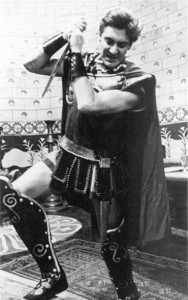 This version of Troy is actually pretty good. I appreciated the exchange between Menelaus and Agamemnon that makes it clear Helen was merely an excuse for a war that had deep political motives. The scene where Paris is sent out by his family to challenge Achilles to a duel and quietly whispers his declaration so as not to actually find Achilles, is now part of my personal historical canon.
This version of Troy is actually pretty good. I appreciated the exchange between Menelaus and Agamemnon that makes it clear Helen was merely an excuse for a war that had deep political motives. The scene where Paris is sent out by his family to challenge Achilles to a duel and quietly whispers his declaration so as not to actually find Achilles, is now part of my personal historical canon.
Most of all, I like that the time travellers are fairly honest about their origins. Sure, the Doctor takes absolute advantage of the fact that the Greeks think he is Zeus (and is regretting it by the end), but he also openly discusses space and time travel, and Vicki’s acceptance into the Trojan royal family is based largely on her innocent honesty about who and what she is. Later she is forced to dissemble, mostly so that the Trojans don’t kill Steven, but there’s very little sense that the TARDIS crew are trying to protect history – instead, history is sucking them in.
I love the book of this story, and very much enjoy listening to the soundtrack which is made coherent by the linking narrative of Peter Purves, but I would love to see the visuals. Maybe not the visuals we actually would have got in 1965 (though many of the performances are wonderful, even the dreadful ones), but this would be a fabulous story to see animated in the 21st century.
“Then woe to Troy! Woe the house of Priam!”
“I think it’s a bit late to say ‘whoa’ to the horse!”
ELSEWHERE ON 1965:
Galaxy Four [Wife in Space]
Galaxy Four [Kasterborous]
Mission to the Unknown [Chronic Hysteresis]
The Feast of Steven [Chronic Hysteresis]
Dr Who and the Daleks [Wife in Space]
Daleks in Technicolour! [TansyRR.com]
November 27, 2012
The Next Big Thing
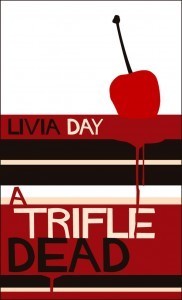 Kirstyn McDermott tagged me to take part in the Next Big Thing, a chain of Wednesday author & book recommendations. Not sure how and where it got started – everyone I know has cited Doctor Who & ‘comic gothic mystery’ writer Paul Magrs as the beginning of the chain, but if you pop back to that original post, you can see that he was also tagged by another writer, and so on. MAYBE IT HAS ALWAYS BEEN HERE.
Kirstyn McDermott tagged me to take part in the Next Big Thing, a chain of Wednesday author & book recommendations. Not sure how and where it got started – everyone I know has cited Doctor Who & ‘comic gothic mystery’ writer Paul Magrs as the beginning of the chain, but if you pop back to that original post, you can see that he was also tagged by another writer, and so on. MAYBE IT HAS ALWAYS BEEN HERE.
Anyway, here are my answers to the questions:
What is the working title of your next book?
A Trifle Dead, which I am releasing under the new pen-name of Livia Day. It will be out in Feb/March 2013 which is not that far away at ALL.
Where did the idea come from for the book?
The original idea is from so long ago it feels like a different person came up with it! Back in my late teens, I wanted to write a fun murder mystery which showed Hobart as a place of cafe culture, art, tourism, vintage boutiques and so on. The first version of the book, which I drafted when I was sixteen (the first manuscript I ever finished!), was mostly terrible, but the idea of it stuck with me until I was ready to try again.
I continued to feel that need for fun, awesome Hobart-based stories through my 20′s. Most of the fiction I ever found set in my home town didn’t feel remotely familiar to me, or relevant to the young people that I knew. Now, of course, we have MONA, Amanda Palmer & Lonely Planet all endorsing Hobart as a cool place to hang out. But when I was younger, most of the books about Tasmania I came across were Oh So Serious literature, ghost stories or “improving” children’s books.
Then there was the cafe itself, which popped into my head because there’s this gorgeous sandstone building in the middle of the city which was a beloved bookshop when I was little, but by my teens had been taken over by all kinds of boring businesses – a surf shop, then a legal firm for a while. A beautiful building like that needed something WONDERFUL in it, and I created “The Troubleshooter’s Cafe” (later “Cafe La Femme”) because of that. These days that building actually houses a gorgeous retro children’s boutique called Ruby’s Room, which makes me terribly happy. I think Tabitha would approve, even if they don’t serve salads.
What genre does your book fall under?
Crime! If it had come out ten years ago it would have been called chick lit crime, but I think the chick lit tag has fallen out of marketing favour. I’m going with ‘culinary crime’ because of the focus on the cafe as the centre of the action. And also the gratuitous use of trifle in the title as well as the story. There are a lot of sticky desserts. And recipes at the back…
What actors would you choose to play the part of your characters in a movie rendition?
This one caused me more trouble than I first imagined! Most of the characters are in their 20’s, and I just don’t watch enough Australian drama featuring characters in that age group. Most of the actors I could even name are pushing 30 at the very least…
As long as they were all-Aussie (or New Zealanders), and there was a cute Scotsman imported to play Stewart, I’d be pretty happy. But if there was a time machine involved I would be attempting to snatch 20-something versions of Nadine Garner and Gia Carides out of their respective timelines to play Tabitha and Xanthippe. And maybe a baby-faced Ewan McGregor for Stewart while we were at it!
What is the one sentence synopsis of your book?
Murder is on the menu at Cafe La Femme – and Tabitha Darling is not happy about it.
Will your book be self-published or represented by an agency?
It will be published by Twelfth Planet Press, and was an unagented sale.
How long did it take you to write the first draft of the manuscript?
Six months, eighteen years ago, but almost nothing of that original version survives except three character names and the cafe itself. This one has had a long journey to being a real book. I’m so happy it’s finally here! My sixteen-year-old self would be rolling her eyes at me for taking so long.
What other books would you compare this story to within your genre?
Janet Evanovich’s Stephanie Plum series has always been my inspiration when it comes to light-hearted crime fiction. I also love the culinary crime novels such as Earthly Delights, written by Kerry Greenwood.
Who or what inspired you to write this book?
Sixteen-year-old me wrote that original terrible first draft a million years ago for a college writing course, and after reading it my friend Isabel promptly threw all the entire history of detective novels at my head, to teach me how to write a half decent crime plot next time. She has still forgotten more about the crime genre than I will ever learn! Also, my Dad has been longing for this book to be available ever since he read the original (horrible plot) version. Patience really is rewarded… eventually.
What else about your book might pique the reader’s interest?
It’s a fresh look at Hobart, Tasmania, a city that surprisingly few Australians have managed to visit. I would love A Trifle Dead to inspire more people to revisit their preconceptions about how great our city is. Having said that, I do feel I should confess that the ‘coffee festival’ which features in the book is entirely fictional. Sorry about that!
Check in with the blogs of the following people next Wednesday for their answers:
Narrelle M Harris, Karen Healey, Michael Thomas, Charles Tan
They will tag five (cough, or nearly five) authors/editors themselves the following Wednesday. AND IT WILL LIVE FOREVER.
If anyone wants the last tag from me, I am happy to give it to the first that asks. (I ran out of asking energy & time)
November 26, 2012
Daleks vs. Daughters – Chasing the Next Generation [WHO-50—1965]
 I lost my daughters somewhere around the Marie Celeste. I put on The Chase quite rebelliously, not expecting them to pay much attention to it. Raeli, at nearly 8 years old, has been quite scathingly clear about what she thinks about black and white media.
I lost my daughters somewhere around the Marie Celeste. I put on The Chase quite rebelliously, not expecting them to pay much attention to it. Raeli, at nearly 8 years old, has been quite scathingly clear about what she thinks about black and white media.
But towards the end of the first episode it had caught their attention, with sandstorms and random tentacles and silvery aliens and Daleks bursting up out of the desert floor.
Barbara and Ian have always been good, but I enjoy them so much in these later stories where they have become such accomplished TARDIS travellers, taking their life with the Doctor for granted. Vicki is plucky as well – I love that her first response to the planet Aridius is to race across the sands to see what is over the ledge, and that Ian tromps gamely along with her.
By Episode 2 my girls were both actively watching the story with us, showing concern for Ian and his beautifully striped blazer as he was hurt in a rockfall, worrying about Barbara and Vicki, and rather delighted to discover that Daleks of the 1960’s are entertaining conversationalists. I was particularly pleased how well 3-year-old Jem was enjoying the story.
And then, by the time the actual chase through time began, they began to drift. They were distracted during most of the Empire State Building antics, and Peter Purves’ audition scene in particular (obviously the production team figured anyone who could commit so deeply to a silly role like Morton Dill was worth having around).
By the time the Daleks were clearing out the crew of the Marie Celeste, my girls were both lying on the couch in agonies, chanting “I’m bored I’m bored I’m bored.”
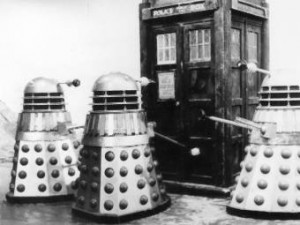 Note to self: when luring little ones into the joys of Classic 60’s Who, never push it more than two episodes per session. Maybe not more than one.
Note to self: when luring little ones into the joys of Classic 60’s Who, never push it more than two episodes per session. Maybe not more than one.
Me, I love The Chase. It’s one of my absolute favourites. The regularly shifting scenes mean that there’s little to no padding, and the whole concept – the Daleks have a time machine and are pursuing the Doctor and his crew from place to place, closing the time gap by a few minutes with every trip – is golden. Sure, you have to have a sense of humour to enjoy it, but it’s one that I clicked with when I was a kid and never lost along the way.
We tried again a few days later, with “Journey into Terror” (AKA the Haunted House episode). I served up dessert, and didn’t tell them I was putting it on. (Thanks to a sudden wave of nostalgia on her part, Jem was literally strapped into her stroller, a captive audience) The girls watched with some degree of fascination this time. Raeli suggested she might be scared by all the ‘nightmare’ iconography of the episode, but little Jem scoffed at her and they ended up quite enjoying it.
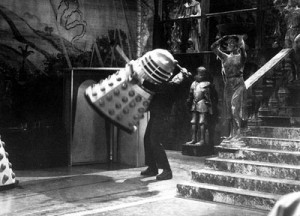 How can you not? This episode has Daleks vs. Frankenstein’s Monster AND Daleks vs. Dracula! Your argument is invalid.
How can you not? This episode has Daleks vs. Frankenstein’s Monster AND Daleks vs. Dracula! Your argument is invalid.
And just as it looks like the episode is going to sink into complete comedy… Vicki is left behind, one of my favourite OMG moments of the show. The Doctor has no control over the TARDIS in this era, and this is the only time that a character is accidentally left behind. What on earth is a girl to do?
“They left Vicki,” Jem said plaintively from her stroller.
“She must be very brave,” Raeli decided when it was revealed that Vicki had actually stowed away on the Dalek ship.
And then when the episode closed on the cliffhanger that the Daleks had created a robot version of the Doctor, both girls clamoured for another one. Which I REFUSED to let them, because it was bedtime. Victory!
I had the hang of it by Episode 5. I served it up with dinner, so that they had no choice but to eyeball the black and white goodness while eating their macaroni cheese and coleslaw. This episode is The One With The Robot Doctor, notable for its quite beautiful if surreal and stagey carnivorous jungle set (seriously, they made an entire carnivorous jungle set for a single episode!), and for the gratuitous use of a body double in the scenes where William Hartnell and his robot double go toe to toe.
“Was this filmed live?” my honey asked in fascination as they deliberately chose not to use William Hartnell in certain shots where they really could have done.
“As good as.”
While Vicki was bullied by giant land-jellyfish, and managed to reunite herself with the TARDIS crew, who promptly all lay down for a random nap, Jemima became utterly fascinated with the Daleks.
By fascinated of course I mean scared, and I watched with muffled squeals of delight as she figured out all on her own what a sofa is for when there are Daleks on screen. That’s my girl! That’s how you do it!
 The experiment wasn’t a total success, as the final episode with so many of my favourite bits – well, Steven Taylor, the Mechanoids and the toy panda, to name three – unfurled with no one quite paying it the appropriate amount of attention. But the battle between the Daleks and the Mechanoids certainly caught the eye of both girls, and they enjoyed the fact that they didn’t quite know which side they should be barracking for (or against).
The experiment wasn’t a total success, as the final episode with so many of my favourite bits – well, Steven Taylor, the Mechanoids and the toy panda, to name three – unfurled with no one quite paying it the appropriate amount of attention. But the battle between the Daleks and the Mechanoids certainly caught the eye of both girls, and they enjoyed the fact that they didn’t quite know which side they should be barracking for (or against).
Raeli had coped quite well with all the black and white, but was utterly baffled by the sequence of stills at the end that celebrated Barbara and Ian’s first day back on Earth. She couldn’t for the life of her see why anyone would choose to do that instead of making the pictures move. She was, however, a bit outraged that I hadn’t warned her ahead of time that it was their last story.
Never mind the fact that she hasn’t seen any of the rest of their adventures, she was sad to see Barbara and Ian go! And so (sniff) was I. It’s always nice to reacquaint myself with the original TARDIS team, and to learn that the First Doctor story that I watched and rewatched most often in my childhood is not entirely inaccessible for the kids of today.
ELSEWHERE ON 1965:
The Rescue [Wife in Space]
The Romans [Kasterborous]
The Crusade [The Memory Cheats]
There will be a bonus 1965 post on Thursday, because I accidentally wrote two!
November 23, 2012
Rolling Around Like Weasels [Xena Rewatch 3.20-3.22]
“Somewhere in this castle he is chained up with two hundred locks… it’s going to take him at least an hour to get out of them.”
Another Autolycus episode! OK it’s been nearly a year for me because for some reason Season 3 got the better of me, but it does seem odd to have two apparently unlinked episodes with the same guest star right next to each other. Even odder that the only reference to previous episodes is that time Xena borrowed his body, and not the time they saw each other just last week. But of course as I keep reminding myself, this is the 90’s model of television, before season-long arcs were officially encouraged, when the ideal was to have episodes that could be shown in random order.
I especially shouldn’t complain about this because thanks to the marvels of Australian television, I did indeed watch most of Xena in entirely the wrong order. As of this rewatch there are still a couple of essential episodes I am yet to see!
In any case, this is a good old fashioned Autolycus romp, in which he is taking one of his rare tourist trips to the right side of Xena’s moral line, which means she has an excuse to enjoy a mad heist with him. (And indeed the whole question of moral lines is explored further, as it turns out that Auto is firmly in the ‘no killing people’ camp while Xena only draws the line at profiting from crime (okay, and cold-blooded execution).
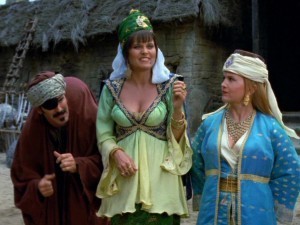 After the drama of Tsunami, this one is a flat out comedy, complete with girning, pratfalls and cartoony sound effects. None of which seems overly necessary when the real humour comes from Xena playing dress ups (it is an essential character trait that our hardbitten, poker-faced heroine adores any excuse to put on a fake accent and act like a maniac) and Gabrielle impersonating a fence without being entirely sure what the word means.
After the drama of Tsunami, this one is a flat out comedy, complete with girning, pratfalls and cartoony sound effects. None of which seems overly necessary when the real humour comes from Xena playing dress ups (it is an essential character trait that our hardbitten, poker-faced heroine adores any excuse to put on a fake accent and act like a maniac) and Gabrielle impersonating a fence without being entirely sure what the word means.
The trick to this one is that it isn’t quite the fluffy farce it appears to be up front (okay, it mostly is) with some revelations about Autolycus’ tragic past, and what made him into the king of thieves in the first place. The emotional stuff is pretty reliant on some ‘as you know Gabrielle’ exposition, but the fact that the story revolves around the ‘true bromance’ friendship that exists between Xena and Autolycus basically saves it.
I very much like the trust and competence of all three main characters in this, and the way that Xena and Gabrielle have such faith in and respect for Autolycus’ skills and vice versa – makes me realise how often fantasy adventure fails to do this. I also like that the story is mostly about the women being protective of their male friend, and his emotional wellbeing. He’s the vulnerable one in this story.
Will Autolycus win back his title of the King of Thieves, or will he turn to the dark side by murdering the man who killed his brother long ago? Whose method will win, Xena’s “good old fashioned kick butt that’s my warrior princess action” or Auto’s trickery and illusion?
Callisto: Not happy to see me, are you? Neither am I, really.
Callisto drags herself out of the last stop-gap measure to keep her from wreaking havoc on the world (for once, not a rockfall), escaping the ‘prison between dimensions’ from Armageddon Now. There are quite a few other old friends back in this big season finale that would, once again, pull the rug out from under the feet of our heroines.
Mysterious priests in red and black, chanting? An innocent girl set to be sacrificed to bring back the return of a goddess? This all sounds quite familiar.
We get Ares back too, freshly cranky from his last Callisto/Hercules crossover, and determined to beat the chainmail bikini goddess of battle-screams even if that means hooking up with Xena again – oh, who are we kidding? He’d take any excuse to fling himself at Xena’s feet. Ares actually spends most of the first part of this story begging Xena to come play war.
The new priests are using a lot of Maori style dancing and costume elements, which is unfortunate because in this universe, that reads as ‘Amazon,’ and they definitely aren’t that. More misdirection? Possibly. The important thing is that they are celebrating the return of a ‘goddess of the blood,’ and we all know who that is, don’t we?
Callisto is her usual ruthless awesomeness, happy to sword fight with Xena (“It’s just for decoration”) or to swap burning balls of godfire with Ares. But there’s a new edge to her – she has moved even further over the suicidal edge she has been toying with for her entire character arc, and is a touch more bonkers than ever before.
She’s also a red herring. The new priests of the ‘goddess of the blood’ don’t even know who Callisto is. They’re all about a different goddess, who is in serious need of being reborn. Oh yeah, baby. Hope, daughter of Dahak and Gabrielle, is coming back to prove all over again how ironic her name is.
The rebirthing is deliciously gross, far more than any other ‘back from the dead’ storyline this show has tackled. Hope is regrown in a flesh cocoon, and fed regular fresh corpses by her surprisingly loyal servant Callisto (who is in it for the ultimate reward, oblivion).
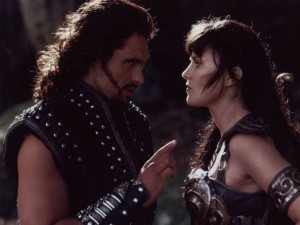 Meanwhile, Gabrielle struggles with her childhood friend, a sweet girl called Seraphin who is now a loyal follower of Dahak and Hope. It makes for an interesting exploration of reality vs. mythology, and how religion can possibly function in a world where the gods are walking around being assholes half the time. Gabrielle is in the surreal position of having to debate theology with her friend about a god she knows more personally than any other – and to reconsider her own role in the cult and mythological traditions surrounding Hope.
Meanwhile, Gabrielle struggles with her childhood friend, a sweet girl called Seraphin who is now a loyal follower of Dahak and Hope. It makes for an interesting exploration of reality vs. mythology, and how religion can possibly function in a world where the gods are walking around being assholes half the time. Gabrielle is in the surreal position of having to debate theology with her friend about a god she knows more personally than any other – and to reconsider her own role in the cult and mythological traditions surrounding Hope.
Bringing Hope back yet again after the massive storyline mid-season could have been dreadful, but it works because this time there is no doubt in Xena and Gabrielle’s hearts that they are on the same team, and even though they play with the audience a little about the idea that Gabrielle might once more choose her daughter over her friend, that was never seriously an option.
There’s a different betrayal on the cards, though. Ares reminds Gabrielle of the debt she owes him, for providing her with some speedy transport back in the appropriately named episode “The Debt.” For payback, he takes her to the Fates who prophesy that if Xena kills Hope, Xena will die.
Interesting, isn’t it? Ares could cash that debt in for anything, and he chooses to use it as leverage for Gabrielle to save Xena’s life, even though that’s going to be her default setting anyway. There couldn’t be anything else going on here, could there?
Gabrielle stops Xena from killing the only-vulnerable-until-fully-reborn Hope, causing her to miss a vital window of opportunity. The final reveal of the episode as the cocoon squelches open is that Hope is all grown up now, no longer played by a ginger cherub, and guess what? She looks exactly like her mother. Yay for Renee O’Connor getting to play a dual role, because she rocks at it. Not so yay for the future of Xena and Gabrielle.
Cue the closing credits…
Callisto: Oh, the mother and child reunion. I’m all misty-eyed.
The twist for Part 2 is not just that Hope is now a dead ringer for Gabrielle. It’s more disturbing than that. The twist is that Ares has given up on ever seducing Xena back and thrown his support to Dahak, despite (or perhaps because of) all previous fears about what this new god would do to his own kind. As a measure of good faith, Ares is also offering his sexy bod in service to Hope so they can sire a new race of gods together.
Yes, Gabrielle, your daughter has a taste for bad boys in leather. And poor old Callisto has to put up with the two of them making out in front of her. No wonder she craves oblivion.
Ares: You are so not like your mother.”
Callisto: The sight of her and Ares rolling around like weasels made me sick. Yes Gabrielle, it seems your daughter is in heat.”
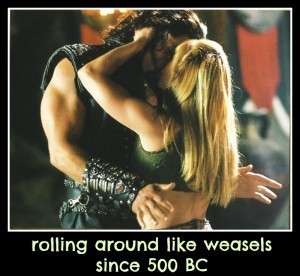 While Gabrielle is determined that Xena should not cause her own death by killing Hope, that doesn’t leave many reliable options, especially now Hope is so powerful.
While Gabrielle is determined that Xena should not cause her own death by killing Hope, that doesn’t leave many reliable options, especially now Hope is so powerful.
Xena herself is happy to die if that means ridding the world of Hope, and preventing more parents from the loss she endured. Meanwhile, Callisto loses faith that Hope is going to live up to her promise, and tries switching sides to achieve her own desired death, but Xena remains unforgiving: she doesn’t see why she should bring peace to the person who helped Hope murder her son.
Xena: May you live forever.
But of course, the team up was inevitable – and there’s nothing quite like Callisto, Xena and Gabrielle sharing an intimate campfire under the light of yet another full moon.
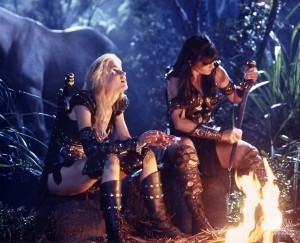 This episode is a love letter to the show so far, touching on so many familiar beats – Xena’s late night ability to sense Ares’ presence, Joxer’s incompetent reputation allowing him to be a secret weapon, Gabrielle’s little stick, Callisto’s pyromania, Ares getting his lust on and so many of the fan favourite duels and pairings.
This episode is a love letter to the show so far, touching on so many familiar beats – Xena’s late night ability to sense Ares’ presence, Joxer’s incompetent reputation allowing him to be a secret weapon, Gabrielle’s little stick, Callisto’s pyromania, Ares getting his lust on and so many of the fan favourite duels and pairings.
It’s nice in a way, because this was the last time that Xena would properly look like this. The next three seasons would be constantly questioning and re-inventing what the show was. End of an era in so many ways…
Renee O’Connor does a brilliant job with the emotional material here: Gabrielle having to deal with her pregnant evil daughter (Gabrielle’s gonna be a grandma and Ares her son-in-law!) and Hope’s surprising vulnerability in facing the mother who abandoned her as a baby and killed her in her childhood.
Hope: Come, be my mother.
Gabrielle: Hope, when I gave you the poison…
Hope: I forgive you.
Gabrielle: I’m so sorry it didn’t finish you.
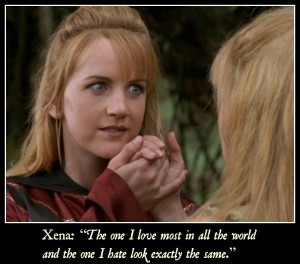 Xena spends this episode walking towards her death, knowing that she will have to sacrifice herself to end the threat of this most evil of gods. And Gabrielle quietly spends the episode knowing she won’t let that happen. It sums them up so well, and of course, in the final moments, it’s not Xena who manages to topple Hope into the endless abyss, it’s Gabrielle who does it, falling to her death in a lava river in front of Xena and Joxer, the two people who love her most.
Xena spends this episode walking towards her death, knowing that she will have to sacrifice herself to end the threat of this most evil of gods. And Gabrielle quietly spends the episode knowing she won’t let that happen. It sums them up so well, and of course, in the final moments, it’s not Xena who manages to topple Hope into the endless abyss, it’s Gabrielle who does it, falling to her death in a lava river in front of Xena and Joxer, the two people who love her most.
She’s died before, but this is the big one. And it’s hard to ignore that Ares has a big part in Gabrielle choosing to make her sacrifice – despite all his apparent allegiances with the Big Bad, keeping Xena alive is still his top priority. That’s going to mean more, in future seasons of the show.
Callisto is really the star of this story: queen of battle screams and rockfalls. She’s scarier and more vengeful than ever before, and she gets all the best lines. Which is as it should be, because “Sacrifice” is her swan song.
Callisto: Seeing poor dear Gabrielle sacrifice makes it all worthwhile. It finally gives me a reason for living and I have you to thank, Xena…
(Callisto giggles helplessly, the last line cut off as Xena stabs her)
Xena: No more living for you.
So yes, Xena kills Callisto. Properly, this time. The fury and shock of Gabrielle’s sacrifice is the only thing that allows her to overcome her (current) moral line and her previous determination to let Callisto live with herself. She uses the hind’s blood dagger to give her greatest enemy what she has been asking for all through the episode – oblivion.
And, as she falls, Callisto is grateful.
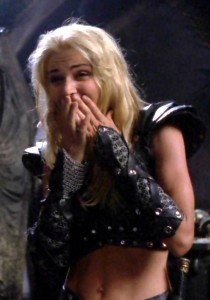 Since she first stepped into the show at the end of season one, Callisto has been strutting and laughing, destroying and bitchfacing her way across the screen, devastating Xena and Gabrielle both individually and together. She even briefly replaced Xena’s body with her own. And now her story is done.
Since she first stepped into the show at the end of season one, Callisto has been strutting and laughing, destroying and bitchfacing her way across the screen, devastating Xena and Gabrielle both individually and together. She even briefly replaced Xena’s body with her own. And now her story is done.
One of the most important choices that the Xena production team did was to end Callisto’s story here, at the end of season three, and never to bring her back (apart from a distant epilogue which will be discussed when we get to it). They never did manage to replace her villainwise (no one could!)… but bringing her story to a crescendo and a conclusion before she became a diluted parody of herself was a class act.
So the antagonists are all gone, but so is Gabrielle. What is Xena going to do for the next three seasons without her best friend to keep her on the straight and narrow?
Stay tuned to find out.
CHAKRAM STATISTICS:
People who want romance with Xena: 13
People Xena allows to romance her: 7
Xena dead lovers: 3
Gabrielle dead boyfriends: 2/7
“Adorable” children: 36
Babies: 5
Babies tossed humorously in the air during fight scenes: 6
Xena doppelgangers: 4
Xena sings at a funeral: 3
Gabrielle sprained ankles: 2
Xena dies: 3
Gabrielle dies: 4
Characters brought back from the dead (incl. ghosts and visits to the Underworld): 22
Ares loses his powers and goes all to pieces about it: 2
Xena or Gabrielle earns money: 2
Xena or Gabrielle spends money (or claims to have money to spend): 7
Out of the Pantheon: Morpheus, Ares, Hera, the Titans, Hades, Celesta, Charon, the Fates, Bacchus, Aphrodite, Cupid, Poseidon, the Furies, Discord
The Celebrity Red Carpet of the Ancient World: Pandora, Prometheus, Hercules, Iolaus, Sisyphus, Helen of Troy, Paris, Deiphobus, Menelaus, Euripides, Homer, Autolycus, Meleager, Oracle of Delphi, David, Goliath, Orpheus, Julius Caesar, Brutus, Ulysses, Penelope, Cecrops, Boadicea, Cleopatra, Crassus, Pompey
Previous Xena Rewatch Posts:
Warlord is a Lady Tonight
I Don’t Work For Money
Amazon Wanna Take A Ride?
Go To Tartarus!
Swashbuckle and Shams
Death In A Chainmail Bikini
Full Moon It Must Be Xena
How Do You Mortals Get From Day to Day?
The Future is Archaeologists
Divide and Conquer
My Sword is Always Ready to Pleasure You
Hide the Hestian Virgins!
Lunatic with Lethal Combat Skills
Coping with Your First Kill
Sweet Hestia, I’m In a Den of Filth
The Bitter and Sweet of It
Because Caesar Was Taken
Armageddon When??
November 22, 2012
Friday Links the Squeeful Edition
 It’s Black Friday (for Americans) and Doctor Who Day for everyone! Yes, 49 years ago today, a certain weird little science fiction show started on British TV. I’m already underway on my WHO-50 project to celebrate the fiftieth year, but in the mean time I can’t think of a better way to celebrate Doctor Who than to check out Kmasca’s awesome Doctor Who Barbie collection, costumes courtesy of the 1980′s Doctor Who Pattern Book.
It’s Black Friday (for Americans) and Doctor Who Day for everyone! Yes, 49 years ago today, a certain weird little science fiction show started on British TV. I’m already underway on my WHO-50 project to celebrate the fiftieth year, but in the mean time I can’t think of a better way to celebrate Doctor Who than to check out Kmasca’s awesome Doctor Who Barbie collection, costumes courtesy of the 1980′s Doctor Who Pattern Book.
I also squeed mightily this week when Love and Romanpunk was featured on the SF Squeecast. Thanks to Lynne and Seanan for saying such lovely things about my beloved purple book, and Twelfth Planet Press in general. I also really enjoyed listening to Paul Cornell raving about Quatermass, and what it contributed to British culture and SF television in general.
A powerful piece from Kyrax2, the writer and fan often referred to as ‘the Comicon Batgirl’ about what actually might be going on with the official DC antipathy towards the character of Stephanie Brown: We hear you, so shut up already!
Tim Coronel, former publisher of Bookseller and Publisher magazine, talks about the changing face of publishing, especially in Australia – some sobering and interesting stuff! – at the Wheeler Centre.
Meanwhile Joel Naoum from Momentum talks about what he thinks readers actually want from e-books – BOOKS, who’d have thought? Thanks Sean the Blogonaut for passing this link on, I think I will be reading this blog regularly now.
Speaking of Sean, he interviews Joe Abercrombie for Galactic Chat – if you missed Joe while he was travelling through Australia (or even if you didn’t) here’s a great chance to hear him speak.
Karen Healey wrote two essays as part of her ongoing series about Sleeping Beauty – Transformation & Codification (the Grimm Brothers & Tchaikovsky), and Disneyfication (well, guess!).
Cheryl Morgan blogged about the horrible misrepresentation of trans people in mainstream media on the Transgender Day of Remembrance – though happily the article in question was revised in response to complaints.
An important article (thanks Narrelle for pointing out this one!) about how judging women for their bodies goes both ways, and how thinness is often policed in our culture in unfair and unreasonable ways: An Apology to My Thinner Friend.
The BBC is producing a drama about the War of the Roses from the point of view of the women involved in the story, which sounds ambitious and amazing.
A six year old girl challenges Hasbro about the gender imbalance in Guess Who?, pointing out the real gender-based consequences of doing this in a game – ie it’s easier for her brother to win.
Lionsgate have had massive success this year with female-led action films. Here’s hoping this is treated seriously and not as a fluke.
Happy Doctor Who Day!!!
November 21, 2012
Where the Wonder Women Are: #29 Hawkeye
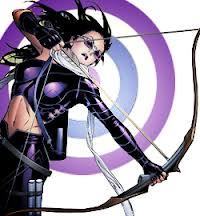 One of the big traditions of superhero comics is the legacy name – a superhero identity that gets passed from character to character, either permanently or (more commonly) until its original owner returns to duty. There’s also a tradition of the gender-switched version of a famous name, such as Supergirl, which is often interpreted as a sexist gesture and a copycat character when in fact it’s often a sensible business decision in an industry where association with iconic status counts for a lot (as well as being at least partly a sexist gesture, but what are you gonna do?).
One of the big traditions of superhero comics is the legacy name – a superhero identity that gets passed from character to character, either permanently or (more commonly) until its original owner returns to duty. There’s also a tradition of the gender-switched version of a famous name, such as Supergirl, which is often interpreted as a sexist gesture and a copycat character when in fact it’s often a sensible business decision in an industry where association with iconic status counts for a lot (as well as being at least partly a sexist gesture, but what are you gonna do?).
Batman, Superman, Green Arrow, Wonder Woman, Green Lantern, Spider-Man, Captain America, Black Widow and the the Hulk have all had someone else try out their name or costume at least once, and/or had at least one younger or gender-switched version of their own character spun off from their famous name.
But it usually comes back to the original being, well, the original. The one with enough nostalgia mileage that they can be used at any point to sweep the universe back to the status quo. The most ‘iconic’ version of the character. When the original makes a return, the stand-in always steps aside, or is conveniently killed, or takes a new name with a certain amount of good grace.
And then there’s Hawkeye.
Thanks to Jeremy Renner and a smart script, Hawkeye (Clint Barton) was one of the revelations of the recent Avengers movie. Who would have thought that the archer character with no superpowers who wears a daft purple suit in the comics and had spent most of the last decade officially dead would have emerged from that movie a fan favourite? And that he would get his own book before Black Widow did?
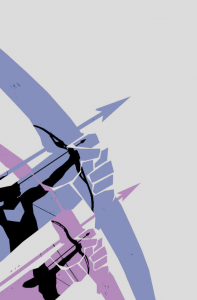 Okay, maybe that part was inevitable.
Okay, maybe that part was inevitable.
But the really interesting part about Hawkeye for me personally is that the character is also a girl.
Back in 2005, Kate Bishop joined the Young Avengers, a book which was all about the legacy and new generation of heroes in the Marvel Universe. A trained martial artist and expert archer, she encountered the junior team as a civilian and later tracked them down to their headquarters. She borrowed costume items from believed-dead former Avenger Hawkeye and his estranged wife Mockingbird, took Hawkeye’s bow for herself and invited herself to join the team.
While she had no particular connection to the not-actually-dead-as-it-turned-out Hawkeye, Kate took the name to honour her fellow archer. Many of her teammates were actually the children of or younger relatives of original Avengers, and it mad sense at the time. She also had a lot of personality traits in common with Clint Barton, as revealed since her introduction – she is snarky, confident and comes from a privileged, moneyed background.
Also, she shoots arrows super good.
Kate first met the “real” Hawkeye when Clint (still I believe pretending to be dead) was impersonating the recently dead (but he got better later) Captain America in the middle of the Civil War event, which pitted superheroes who supported government regulation against superheroes who supported privacy of information.
While Kate had no idea who Clint was, she was furious at him for taking on Cap’s persona, especially to fight for the ‘government knows best’ side, when the real Captain America had been assassinated while fighting the other side.
She declared that she would never have worn the original Hawkeye’s costume, and also that she was honouring, not mimicking a fallen hero herself. “If Hawkeye were alive, I’d call myself something else.”
Ashamed, Clint returned Captain America’s costume to Tony Stark and ditched the whole Civil War plot. He later approached Kate and tested her abilities before revealing who he really was. And that he wanted his bow back, please.
Kate rose to the challenge but lost, surrendering both the bow and her codename. Clint then insisted that she keep and use both. They can both be Hawkeye. Why the hell not?
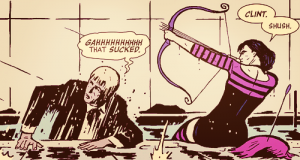 The new Hawkeye series, written by Matt Fraction and drawn by David Aja, is one of the best new titles I have read in years. It’s so damn good. Clint is interpreted as a cranky urban noir anti-hero, dealing with petty crime and mobsters. His lack of superhero powers only serves to make the story more credible, and his unrelentingly macho voice works beautifully with the elegant, purple-toned illustrative art.
The new Hawkeye series, written by Matt Fraction and drawn by David Aja, is one of the best new titles I have read in years. It’s so damn good. Clint is interpreted as a cranky urban noir anti-hero, dealing with petty crime and mobsters. His lack of superhero powers only serves to make the story more credible, and his unrelentingly macho voice works beautifully with the elegant, purple-toned illustrative art.
Yes, I actually love a bit of macho noir, especially when it’s done intelligently. I was raised on Spenser novels and Phillip Marlowe, you know!
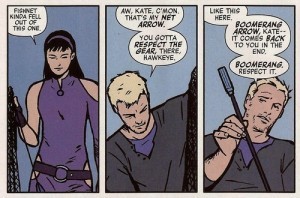 But there’s more to this comic than meets the eye. Matt Fraction, one of the sneakiest feminist writers in the business (this is the man who gave Pepper Potts her own battle suit), not only put Kate Bishop squarely into issue 2, he made her a protagonist equal to Clint. So yes, you know how we’ve been counting all the new Marvel titles with female leads? Hawkeye is actually one of them.
But there’s more to this comic than meets the eye. Matt Fraction, one of the sneakiest feminist writers in the business (this is the man who gave Pepper Potts her own battle suit), not only put Kate Bishop squarely into issue 2, he made her a protagonist equal to Clint. So yes, you know how we’ve been counting all the new Marvel titles with female leads? Hawkeye is actually one of them.
The Hawkeyes are fantastic together. They have one of those gorgeous unromantic male-female friendships that is such a rarity in stories (and I hope, hope, doesn’t get stuffed up by one of them getting a crush, there is one line of dialogue that worries me). The two of them banter their way through the hardboiled storylines like they are living in a Thin Man movie marathon, and neither of them have any illusions about such realities as Clint’s ridiculous sexcapades, the life expectancy of any car they happen to acquire, or what the hell use a collection of trick arrows is without a comprehensive labelling system.
I love them so much, the Hawkeyes. Most of all I love that Clint is now being portrayed as one of those blokes who respects his female comrade completely, and trusts in her competence (while she trusts him only as far as she can throw him, which is fair enough given the known facts about his general behaviour).
 Could be the beginning of a beautiful friendship.
Could be the beginning of a beautiful friendship.
I’ve had my eye on Kate Bishop for a long time, and it’s exciting to see her being handled in such an excellent way, in a high quality title that I think will stand for a long time as an example of how to write great female comic book characters.
Kate’s Hawkeye will also be appearing in the Marvel Now new title of Young Avengers, written by Kieran Gillen (Generation Hope) and drawn by Jamie McKelvie, who both talk about the new book here. I’m glad to see how much respect they have for the current Fraction & Aja Hawkeye title, and that they plan to continue the visuals and characterisation of that series.
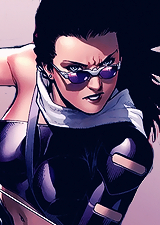 Here’s hoping that the popularity of the Jeremy Renner movie version of Hawkeye spills over not only into the comics, but into support for Kate Bishop too. We don’t have to get into flamewars about which Hawkeye is best, when ‘best’ is obviously having both!
Here’s hoping that the popularity of the Jeremy Renner movie version of Hawkeye spills over not only into the comics, but into support for Kate Bishop too. We don’t have to get into flamewars about which Hawkeye is best, when ‘best’ is obviously having both!
Oh, and despite fans’ best efforts, she’s not ‘Girl Hawkeye’ or ‘Lady Hawkeye’ or ‘Ms Hawkeye’ and frankly I don’t think it’s even credible to call her ‘Hawkeye II.’ He’s Hawkeye, and so is she. Deal with it.
Where the Wonder Women Are:
0: Introduction
1: Black Canary
2: Rogue
3: Hawkgirl/Hawkwoman
4: Black Widow
5: Wonder Girl
6: Captain Marvel 7: Vixen
7: Vixen
8: Abigail Brand
9. Jubilee
10. Batwoman
11. Catwoman
12. Huntress
13. Robin
14. Batgirl
15. Jean Grey
16. Ice
17. Emma Frost
18. Fire
19. Lady Sif
20. Supergirl
21. The Wasp
22. Gypsy
23. Misty Knight (and Colleen Wing)
24. Mystek
25. Kitty Pryde
26. Crimson Fox
27. The Invisible Woman
November 20, 2012
Friend of Finland? Buy Books!
The Finnish science fiction community has organised a Facebook-based book-buying spree to support Cheryl Morgan and her Wizard’s Tower ebook store. (look, you can go straight to her store and avoid Facebook, that’s two good deeds!) Cheryl curates a fabulous selection of e-books, with an emphasis on literary/small press SF and fantasy, and a diverse range of feminist, queer and not-just-from-UK-and-US authors.
I just bought Karin Tidbeck’s Jagannath after hearing Jonathan & Gary talk about the book on the Coode Street Podcast yesterday. Not quite an impulse buy, but I’m still very excited to read it. I can also highly recommend Beyond Binary by Brit Mandelo, Diana Comet and Other Improbable Stories by Sandra McDonald, Ishtar by our own Deborah Biancotti, Kaaron Warren and Cat Sparks, and the Tiptree-award winning Redwood and Wildfire by Andrea Hairston.
Also, you know, there’s this:


